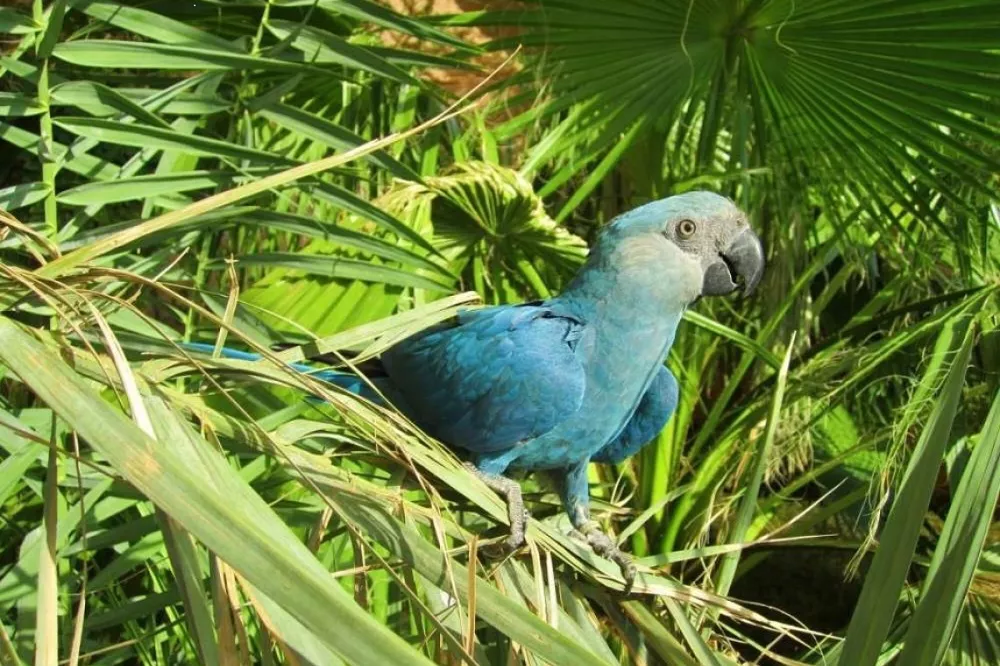Spix’s Macaw, also known as the Little Blue Macaw or Cyanopsitta spixii, is a rare and endangered bird species native to Brazil. This beautiful parrot has captured the hearts of many with its stunning blue feathers and charming personality. Unfortunately, due to habitat loss and illegal trapping for the pet trade, Spix’s Macaw is now considered one of the world’s most endangered birds.
In this article, we will delve into the fascinating world of Spix’s Macaw, exploring the bird’s history, biology, behavior, habitat, and conservation efforts.
History
Spix’s Macaw was first described in 1819 by German naturalist Johann Baptist von Spix, who gave the bird its scientific name. The species was once widespread throughout the northeastern region of Brazil, but by the late 20th century, it had become extremely rare due to habitat loss and trapping for the pet trade.
In fact, the last known wild Spix’s Macaw disappeared in 2000, leaving behind a single captive population consisting of only around 80 individuals worldwide. Since then, intensive conservation efforts have been underway to save this critically endangered species from extinction.
Appearance
Spix’s Macaw is a small to medium-sized parrot, measuring around 56 cm (22 inches) from head to tail. Its most distinctive feature is its vibrant blue plumage, which covers most of its body except for its forehead, crown, and nape, which are bare and pale grey.
The bird’s beak is black and slightly curved, allowing it to crack open hard nuts and seeds. Its feet are zygodactyl, meaning that two toes point forward while the other two point backward, enabling the bird to grip branches and climb trees with ease.
Behavior
Spix’s Macaw is an intelligent and social bird, known for its vocalizations and playful nature. Like all parrots, it has a strong beak and can use it to chew and destroy objects, including furniture and electrical wires.
In the wild, Spix’s Macaw feeds mainly on seeds, nuts, and fruits, and occasionally on insects and their larvae. It is also known to visit clay licks, where it consumes mineral-rich soil that aids in digestion.
Habitat
Historically, Spix’s Macaw inhabited the dry Caatinga scrubland of northeastern Brazil, where it nested in tree cavities and foraged for food in the surrounding vegetation. The bird was particularly associated with the caraibeira tree (Tabebuia aurea), whose hard nuts provided a significant portion of its diet.
Today, due to habitat loss and fragmentation, the species’ range has shrunk considerably, and the remaining wild population is believed to be extinct. However, efforts are ongoing to restore the bird’s habitat and reintroduce it to the wild.
Conservation Efforts
Spix’s Macaw is considered one of the world’s most endangered birds, with only around 80 captive individuals surviving today. In an effort to save the species from extinction, several conservation organizations have joined forces to implement a comprehensive conservation program that includes captive breeding, habitat restoration, and reintroduction.
The Spix’s Macaw Conservation Program, led by the Brazilian government’s Chico Mendes Institute for Biodiversity Conservation (ICMBio), aims to establish self-sustaining populations of the bird both in captivity and in the wild. To achieve this goal, the program follows a five-stage plan that includes:
Captive breeding: Breeding pairs of Spix’s Macaws are housed in specialized facilities around the world, where they are carefully monitored and managed to ensure genetic diversity and maximize reproductive success.
Habitat restoration: Efforts are underway to restore degraded habitats in northeastern Brazil, including planting caraibeira trees and other native vegetation to provide food and nesting sites for the birds.
Reintroduction: Once suitable habitat is available, captive-bred birds are released into the wild in carefully planned stages to minimize risks and maximize survival.
Monitoring: Released birds are carefully monitored to assess their adaptation to the wild and their reproductive success.
Education and awareness: The Spix’s Macaw Conservation Program also aims to raise public awareness about the bird’s plight and the importance of conservation efforts to save it from extinction.
Conclusion
Spix’s Macaw is a beautiful and charismatic bird species that has captured the hearts of many with its striking blue plumage and playful personality. Unfortunately, due to habitat loss and illegal trapping, the bird is now critically endangered and at risk of extinction.
Thanks to intensive conservation efforts led by the Brazilian government and several conservation organizations, there is hope for the survival of Spix’s Macaw. Through captive breeding, habitat restoration, and reintroduction, the ultimate goal is to establish self-sustaining populations of the bird in the wild and ensure that future generations can enjoy the beauty and wonder of this magnificent species.
Related topics:


 Facebook
Facebook  Instagram
Instagram  Youtube
Youtube 